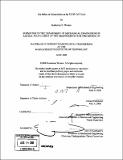| dc.contributor.advisor | Gerard Ostheimer and Nicholas G. Hadjiconstantinou. | en_US |
| dc.contributor.author | Weston, Katherine D | en_US |
| dc.contributor.other | Massachusetts Institute of Technology. Dept. of Mechanical Engineering. | en_US |
| dc.date.accessioned | 2009-04-29T17:17:22Z | |
| dc.date.available | 2009-04-29T17:17:22Z | |
| dc.date.copyright | 2008 | en_US |
| dc.date.issued | 2008 | en_US |
| dc.identifier.uri | http://hdl.handle.net/1721.1/45265 | |
| dc.description | Thesis (S.B.)--Massachusetts Institute of Technology, Dept. of Mechanical Engineering, 2008. | en_US |
| dc.description | Includes bibliographical references (leaves 26-28). | en_US |
| dc.description.abstract | Treatment of U20S cells with the chemotherapeutic drug Doxorubicin results in either apoptosis or cellular senescence. The pathway the cell takes is dependent upon the dosage of Doxorubicin administered to the cells. When a 10 [mu]M dose is administered Topoisomerase II is inhibited resulting in double stranded DNA breaks because the DNA is unable to relegate during synthesis. This is shown by lower levels of synthesis after analysis with Bro mo-2-deoxyuridine (BrdU) and Propidium Iodide (PI) staining. The cells are unable to recover from the severity of this damage and become apoptotic. When a 2 [mu]M dose is applied to the cells, a G2 arrest occurs. This is shown by lower levels of Cyclin B in the G2 phase during flow cytometry analysis and staining with PI. Apoptosis levels are monitored using cleaved Caspase 3 and cleaved PARP. The percentage of 10 [mu]M cells undergoing apoptosis increased steadily over 48 hours, while the 2 [mu]M and untreated cells maintained constant low levels of apoptosis. Both cellular senescence and apoptosis put a halt to cell proliferation. | en_US |
| dc.description.statementofresponsibility | by Katherine D. Weston. | en_US |
| dc.format.extent | 51 leaves | en_US |
| dc.language.iso | eng | en_US |
| dc.publisher | Massachusetts Institute of Technology | en_US |
| dc.rights | M.I.T. theses are protected by
copyright. They may be viewed from this source for any purpose, but
reproduction or distribution in any format is prohibited without written
permission. See provided URL for inquiries about permission. | en_US |
| dc.rights.uri | http://dspace.mit.edu/handle/1721.1/7582 | en_US |
| dc.subject | Mechanical Engineering. | en_US |
| dc.title | The effect of doxorubicin on the U2OS cell cycle | en_US |
| dc.type | Thesis | en_US |
| dc.description.degree | S.B. | en_US |
| dc.contributor.department | Massachusetts Institute of Technology. Department of Mechanical Engineering | |
| dc.identifier.oclc | 310422532 | en_US |
